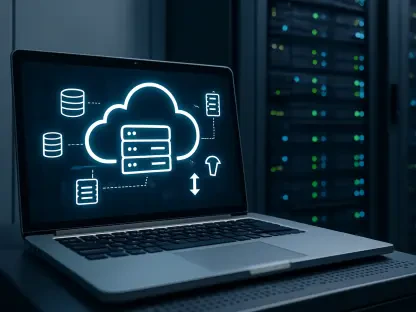What happens when a tool costing just a few hundred dollars can turn anyone into a cybercriminal capable of stealing thousands of passwords? This chilling reality came to light when a sophisticated phishing platform threatened millions of internet users worldwide, prompting two technology powerhouses to join forces and strike at the heart of this digital danger. Their mission revealed not only the scale of the threat but also the relentless innovation required to combat cybercrime in an era where personal and corporate security hang in a delicate balance.
The Alarming Rise of a Digital Menace
The phishing-as-a-service (PhaaS) platform, known as RaccoonO365, emerged as a significant threat, enabling even inexperienced attackers to launch convincing scams. Since gaining traction, it has been linked to the theft of over 5,000 Microsoft 365 accounts across 94 countries, flooding inboxes with hundreds of millions of deceptive emails annually. These messages, often disguised as legitimate business or tax documents, tricked users into surrendering sensitive credentials, amplifying the risk as remote work and cloud reliance continue to grow.
The accessibility of such tools has reshaped the cybersecurity landscape, lowering the barrier for criminal activity. For a subscription fee of $355 for 30 days or $999 for 90 days, payable via cryptocurrency, RaccoonO365 attracted 100-200 active users. This democratization of cybercrime, generating over $100,000 in revenue, underscored a grim truth: sophisticated attacks are no longer the domain of elite hackers but are within reach of almost anyone with malicious intent.
Why This Threat Matters to Everyone
Beyond the staggering numbers, the impact of platforms like RaccoonO365 reverberates through personal and professional spheres. Credential theft often leads to broader breaches, compromising financial accounts, corporate data, and even national security when passwords are reused across systems. The ripple effects can devastate individuals with identity theft and cost organizations millions in recovery and lost trust.
This operation’s significance lies in its exposure of a systemic vulnerability in the digital ecosystem. As more services migrate to the cloud, the stakes for protecting login information have never been higher. The success of this takedown sends a powerful message about the urgent need for collaborative defense strategies, while also highlighting that no single victory can eliminate the ever-evolving nature of phishing schemes.
Unraveling the Mechanics of a Cybercrime Machine
RaccoonO365 operated with alarming precision, offering features that made it a formidable adversary. Its real-time data theft capabilities allowed attackers to capture credentials as soon as they were entered, while evasion techniques outsmarted 17 major security vendors. Utilizing Cloudflare Worker clusters, the platform masked its activities through reverse proxying, blending malicious traffic with legitimate patterns to avoid detection.
Further enhancing its arsenal, the tool recently introduced an AI-powered update known as ‘RaccoonO365 AI-MailCheck,’ showcasing adaptability that kept it ahead of traditional defenses. Managed centrally, operators could roll out new evasion tactics or campaign strategies with minimal effort, ensuring the platform remained a persistent threat. The mastermind behind this operation, identified as Nigerian national Joshua Ogundipe, allegedly authored much of the code, orchestrating attacks through Telegram sales channels.
The financial model of this phishing empire revealed its scale, with subscription payments funneled through cryptocurrency for anonymity. This setup not only fueled the operation’s growth but also illustrated how modern cybercrime mirrors legitimate business structures, complete with pricing tiers and customer support, making it a uniquely dangerous enterprise in the underground economy.
A Bold Strike Against Digital Deception
On September 2, 2024, a pivotal operation unfolded as Microsoft’s Digital Crimes Unit partnered with Cloudflare to dismantle RaccoonO365’s infrastructure. Under a court order from the Southern District of New York, 338 domains tied to the platform were seized, marking a significant blow to its network. Cloudflare’s role was critical, mapping the threat group’s setup through user signup tracking, disabling domains, banning associated scripts, and placing phishing warnings to deter further misuse.
Microsoft’s investigation uncovered crucial evidence, including a leaked cryptocurrency wallet that pointed to Ogundipe as the key figure. This takedown diverged from past efforts by focusing on large-scale disruption rather than isolated actions, aiming to increase the operational cost for cybercriminals. Steven Masada, assistant general counsel at Microsoft’s Digital Crimes Unit, noted, “This effort targeted an entire criminal ecosystem, not just a single tool,” emphasizing the strategic intent behind the move.
Cloudflare reinforced this stance, stating that even their free tier is “too expensive for criminal enterprises,” signaling a commitment to making their platforms hostile to malicious actors. This coordinated strike set a new benchmark for tackling phishing networks, demonstrating how legal authority and technical expertise can converge to disrupt sophisticated threats on a global scale.
Expert Perspectives on a Growing Battle
Insights from industry leaders shed light on the broader implications of this operation. Simon Phillips, CTO at CybaVerse, cautioned that ready-made phishing kits drastically reduce the skill needed for scams, with polished designs and accurate language making them harder to spot. “When credentials are stolen, especially if reused across accounts, the damage can be catastrophic,” Phillips added, pointing to a critical user vulnerability.
The sheer volume of phishing emails—hundreds of millions sent each year—paints a stark picture of the challenge ahead. Experts agree that while this takedown was a major setback for one platform, the underlying ecosystem of cybercrime remains resilient, often rebuilding through dark web resources. This reality drives home the importance of sustained efforts and innovative defenses to counter increasingly deceptive tactics.
The determination to fight back is palpable, as both technology firms and independent analysts stress the need for systemic change. The collaboration seen in this case exemplifies a shift toward proactive measures, but it also serves as a reminder that individual awareness and robust security practices are indispensable in this ongoing struggle against digital fraud.
Staying Safe in a Landscape of Evolving Risks
Even with a significant victory against RaccoonO365, the phishing threat persists as attackers adapt and seek new avenues for exploitation. Strengthening personal defenses starts with unique, complex passwords for every account, ideally managed through a secure password manager to prevent reuse and simplify access.
Enabling two-factor authentication (2FA) on Microsoft 365 and other services adds a vital layer of protection, ensuring that even stolen credentials alone cannot unlock accounts. Scrutinizing emails for subtle signs of fraud, such as mismatched sender addresses or suspicious links, remains essential—hovering over URLs without clicking can reveal hidden dangers.
Staying informed about emerging tactics, including AI-driven scams, through updates from trusted cybersecurity sources equips users to recognize novel threats. Reporting any suspected phishing attempts to IT teams or service providers promptly can limit damage and aid broader defense efforts, reinforcing a collective shield against cybercriminals who continue to innovate.
Reflecting on a Historic Takedown
Looking back, the joint operation by Microsoft and Cloudflare to dismantle RaccoonO365 stood as a landmark moment in the fight against phishing empires. Their strategic focus on disrupting entire networks rather than isolated elements showcased a powerful blueprint for addressing cybercrime at its roots. The identification of key figures and the financial scale of the operation added layers of accountability to an often shadowy domain.
Moving forward, the emphasis must remain on empowering users with practical tools and knowledge to fortify their digital lives. Organizations should prioritize ongoing partnerships and invest in cutting-edge detection systems to anticipate the next wave of threats. As cybercriminals adapt, the lessons from this takedown urge a proactive stance—combining technology, education, and vigilance to build a safer online world for all.









